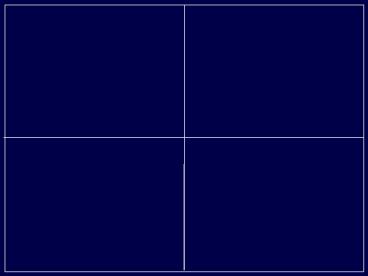Geometrical Optics - PowerPoint PPT Presentation
1 / 57
Title: Geometrical Optics
1
(No Transcript)
2
Page 13.43
Axial Map vs. Instantaneous Map
3
- Localized variations in corneal curvature produce
much larger changes in instantaneous power (given
by ri) - Axial power is less variable because da is
measured to a fixed axis (the reference axis)
Local steepening (ri ltlt da )
Local flattening (ri gtgt da)
da and da do not differ greatly ri gtgtgt ri
ri
da
da
Reference axis
Reference axis
ri
4
Corneal Topography Refractive Map
Page 13.53
- Based on Snells Law of refraction
- n sin i n? sin i?
- Determines non-paraxial image location, thereby
accounting for aberrations (spherical being the
most important) - Refractive Map predicts
- impact of corneal aberrations on retinal image
quality - image quality as a function of pupil diameter
(day vs. night vision)
5
Corneal Topography Refractive Map
Page 13.53
p corneal point
n sin i n? sin i?
p
6
Corneal Refractive Power Paraxial Optics
7
Corneal Refractive Power Snells Law (assuming
spherical cornea)
8
Q1. According to this figure of a spherical
cornea showing Snells Law refraction for
various ray incident heights
- True corneal power increases from center to
periphery - Paraxial corneal power increases from center to
periphery - True corneal power decreases from center to
periphery - Paraxial corneal power decreases from center to
periphery
9
Nidek OPD-Scan II Topographic Maps
Page 13.48
10
Direct Image of Mire Reflection
11
Edge Detection usable topography data
12
Radius variation across cornea
13
Estimated corneal power variation
14
(No Transcript)
15
(No Transcript)
16
(No Transcript)
17
(No Transcript)
18
(No Transcript)
19
(No Transcript)
20
(No Transcript)
21
Regular Corneal Astigmatism
22
(No Transcript)
23
Q2. What type of astigmatism does this image
represent?
- With-the-rule total ocular astigmatism
- With-the-rule corneal astigmatism
- Against-the-rule total ocular astigmatism
- Against-the-rule corneal astigmatism
24
Marked corneal atr astigmatism
25
With-the-Rule Corneal Astigmatism
26
Page 13.55
27
Page 13.56
28
Contralateral eye
29
Marked astigmatism often symmetrical between
eyes. Contralateral eye to Figure 13.43, Page
13.56
30
Oblique Corneal Astigmatism
31
Page 13.59
32
Page 13.60
33
Page 13.48
34
Page 13.49
35
Keratoconus
Page 13.63, 13.67
- Most common corneal degeneration
- Etiology not clearly understood - many theories
(systemic disease, hormonal changes, rigid lens
wear, UVB, mechanical effects - eye rubbing) - More common in males (contradicts earlier
studies) - Detected in second or third decade of life
- Produces a cone-shaped corneal apex
- As cornea degenerates and stroma thins ? patient
develops a high degree of irregular astigmatism - Corneal graft often required in advanced cases
36
Keratoconus
37
(No Transcript)
38
Oval or Sagging Cone - Keratoconus
39
Munsons Sign
Bulging of the corneal apex forms a V-shaped
protrusion of the lower lid in inferior gaze
40
Page 13.63
41
Page 13.64
42
Page 13.65
43
Page 13.67
44
Corneal Models and Detection of Keratoconus
Several research groups have derived analytical
models to predict keratoconus based on a series
of topographic attributes of the corneal
surface These are used as built-in automated
programs in some topographers
45
DSI Area-compensated greatest difference between
any two of eight sectors of the cornea.
Differential sector index
46
Keratoconus Prediction Index Components Klyce
OSI Maximum difference in area-corrected corneal
powers between any two opposites of eight corneal
sectors .
Opposite sector index
Differential sector index
47
Keratoconus Prediction Index Components Klyce
Fig 3.34b - Page 3.63
CSI Area-compensated difference between the
central 3 mm of analyzed area and an annulus
surrounding the central area from an inner radius
of 1.5 mm to an outer radius of 3 mm.
Center-surround index
48
Keratoconus Prediction Index Components Klyce
Opposite sector index
Differential sector index
Center-surround index
49
Keratoconus Prediction Index Components Klyce
Other Parameters
Page 3.63
- IAI - Irregular Astigmatism Index an average of
the inter-ring power variations along every
meridian for the entire corneal surface analyzed.
The IAI increases as local irregular astigmatism
on corneal surface increases.
50
Irregular Astigmatism Index
3 5 2 1 6 .
51
Keratoconus Prediction Index Components Klyce
Other Parameters
- AA - Analyzed Area indicates the fraction of the
the corneal area covered by the mires that is
processed. AA is lower than normal in corneas
with high irregular astigmatism ?mires break up.
52
Rose K Keratoconus Contact Lens
53
Contact Lens Fitting Software
54
Post RK - EyeSys videokeratograph OD
Right eye of a patient I yr after bilateral RK
with OZ's less than 2.0 mm.
55
Post RK - EyeSys videokeratographs OS
Left eye of same patient 1 yr after bilateral RK
(OZ's less than 2.0 mm).
56
S-shaped distortion to the far peripheral placido
rings nasally and temporally Distortion more
clearly visible at higher magnification ?
57
(No Transcript)



























![L 32 Light and Optics [3] PowerPoint PPT Presentation](https://s3.amazonaws.com/images.powershow.com/7515468.th0.jpg?_=20210330103)



